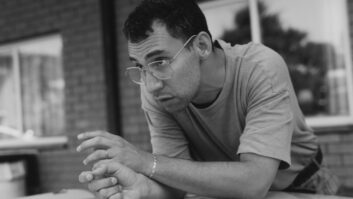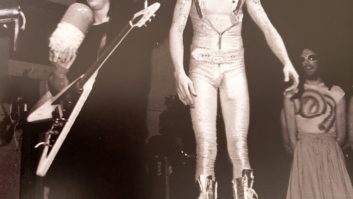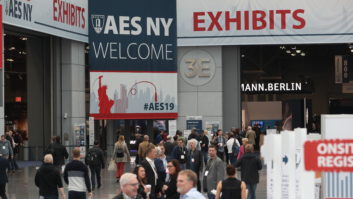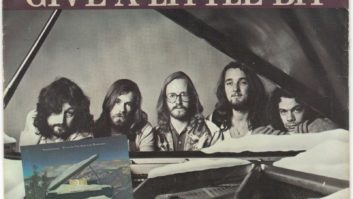It’s hard to believe that Saturday Night Live, the long-running variety show that carries a New York City vibe at its heart, debuted 40 years ago. In the city’s honor, we thought we would take a look back at that Crossroads Year, the middle of one of the most turbulent and dynamic decades in modern times, with an eye on entertainment and audio.
Sherman, let’s head to the Wayback Machine…
January 1975
Sgt. Pepper’s Lonely Hearts Club Band on the Road: A Rock Spectacle at the Beacon Theater closes after 66 performances.

January 5, 1975
The Wiz opens on Broadway at the Majestic Theatre. The production would go on to be nominated for eight Tony Awards that year, winning seven, including Best Musical.

February 3, 7 and 12
Led Zeppelin plays three shows at Madison Square Garden. All three shows had sold out a month earlier in a then-record four hours.
February 7, 1975
The Jackson 5 perform at Radio City Music Hall.

February 14, 1975
Patti Smith Group debuts at CBGB. After numerous appearances throughout the years at the club, Patti Smith would also play CBGB’s final show on October 15, 2006, with help from Flea from the Red Hot Chili Peppers.

February 17, 1975
John Lennon releases his sixth studio album, Rock ’n’ Roll. Lennon produced sessions at Record Plant Studios in New York, while Phil Spector produced some sessions at A&M Studios in Hollywood.
February 27, 1975
Blue Öyster Cult releases their first live album, On Your Feet or on Your Knees. The 12 songs include performances at the Academy of Music in New York City, the Paramount Theatre in Portland, the Paramount Theatre in Seattle, the Show Palace in Phoenix, the Long Beach Arena, the P.N.E. Coliseum in Vancouver and the Capitol Theatre in New Jersey.

March 11, 1975
Alice Cooper releases his debut solo album, Welcome to My Nightmare, which was recorded at Record Plant East, Electric Lady and A&R Studios in New York, as well as Soundstage in Toronto. It was produced and mixed by Bob Ezrin, with engineers Phil Ramone, Jim Frank, Rod O’Brien, David Palmer, Ed Sprigg and Corky Stasiak.

March 19, 1975
Kiss releases Dressed to Kill, which was recorded at Electric Lady Studios. The album was produced by Casablanca Records president Neil Bogart and engineered by Dave Wittman, with George Lopez assisting.

April 8, 1975
Aerosmith releases Toys in the Attic, recorded at Record Plant Studios in New York. The album was produced by Jack Douglas and engineered by Jay Messina, with assistant engineers Rod O’Brien, Corky Stasiak and Dave Thoener. Doug Sax and Vic Anesini handled mastering for the album. The songs were recorded with a Spectrasonics mixing board and a 16-track tape recorder.

April 14, 1975
Bette Midler’s Clams on the Half Shell Revue debuts at the Minskoff Theatre on Broadway.
April 18, 1975
John Lennon plays what would become his final live show, a three-song set, at the Waldorf Astoria Hotel.

May 1, 1975
The Rolling Stones announce their 1975 Tour of the Americas by performing “Brown Sugar” on the back of a moving flatbed truck on Fifth Avenue. At that time, they also announced that former Faces member Ron Wood would be replacing Mick Taylor on guitar.

June 1975
The Talking Heads play their first gig as the “Talking Heads” at CBGB, opening for The Ramones. They would soon become a regular fixture at the club.

June 3, 1975
Chicago: A Musical Vaudeville opened on Broadway June 3, 1975, at the 46th Street Theatre, and ran for a total of 936 performances, closing on August 27, 1977. It was nominated for 11 Tony Awards in 1976.
July 1975
Lou Reed releases the album Metal Machine Music. The album features no songs or structured music and is full of feedback and guitar effects; it was generally panned by critics. However, today the album is regarded as a forerunner of noise rock/industrial music.
July 25, 1975
A Chorus Line opens on Broadway at the Shubert Theatre, where it ran for 6,137 performances until April 28, 1990. It was the longest-running production in Broadway history until it was surpassed by Cats in 1997.

August 25, 1975
Bruce Springsteen releases Born to Run, recorded at Record Plant Studios and 914 Studios in New York. The album was produced by Springsteen, Jon Landau and Mike Appel, and was engineered by Andy Abrams, Angie Arcuri, Ricky Delena, Jimmy Iovine, Louis Lahav, Thom Panunzio, Corky Stasiak and David Thoener. The album was mastered by Greg Calbi.
September 9, 1975
The J. Geils Band releases Hotline, recorded at Record Plant Studios in New York. The album was produced by Bill Szymczyk, Allan Blazek and Seth Justman, and engineered by Blazek, Szymczyk and David Thoener. Alex Sadkin mastered the album.

October 6, 1975
Paul Simon releases Still Crazy After All These Years, recorded at A&R Recording in New York. The album was produced by Simon and Phil Ramone, with Ramone also engineering. Ramone would go on to win a Grammy for Album of the Year in 1976 for his work on this album.
October 11, 1975
Saturday Night Live debuts live from Studio 8H in the GE Building at Rockefeller Center, with George Carlin serving as host and Billy Preston and Janis Ian serving as the musical guests. Preston performed “Nothing From Nothing” and “Fancy Lady,” and Ian performed “At Seventeen” and “In the Winter.” The cast of the show at the time featured Chevy Chase, John Belushi, Dan Aykroyd, Gilda Radner, Garrett Morris, Jane Curtin and Laraine Newman. The show was originally called NBC’s Saturday Night.
October 18, 1975
Simon & Garfunkel reunite on the second episode of Saturday Night Live to perform “The Boxer” and “Scarborough Fair.”
Late 1975
The Ramones were signed to Sire Records by Seymour Stein (president/co-founder of the label). The band would go on to record their self-titled debut album at Plaza Sound (on the eighth floor of Radio City Music Hall), which was released on April 23, 1976.
December 13, 1975
Patti Smith releases Horses, recorded at Electric Lady Studios. The album was produced by John Cale, with Bernie Kirsh engineering. The album was mastered by Kirsh, Vic Anesini, Bob Ludwig and Bob Irwin, with Frank d’Augusta assisting.
NOTEWORTHY MOMENTS IN PRO AUDIO

• Bob Moog releases the Polymoog synthesizer (model 203a)
• Studer moves its American headquarters to Nashville. Also releases the Studer A67, B67 tape machines and the A68 amplifier
• Neumann releases the KU 80
• Harrison 32-series console is released
• SSL 400 A Series is released
• Soundcraft Series Two is released

• New Yorker Ken Schaffer develops the Schaffer-Vega Diversity System, the first reliable wireless system for musicians. The system was key to the sound of many legendary bands, including AC/DC and Pink Floyd. NASA also used the mics to improve astronaut voice communication.
• Rupert leaves Neve in 1975
• The MCI JH-500 is released
• The first dedicated MIDAS monitor console is released, with early customers such as Clair Brothers Audio for clients such as Elvis Presley, Yes, Billy Joel, and the Beach Boys
• The API 3288 is released
• The Roland Jazz Chorus-60 and Roland Jazz Chorus-120 are released

1975 GRAMMY AWARDS
• Record of the Year: John Farrar (producer) and Olivia Newton-John for “I Honestly Love You” (award presented by John Lennon and Paul Simon and accepted by Art Garfunkel)
• Album of the Year: Stevie Wonder (producer and artist) for Fulfillingness’ First Finale
• Song of the Year: Alan Bergman, Marilyn Bergman and Marvin Hamlisch (songwriters) for “The Way We Were,” performed by Barbra Streisand
• Best New Artist: Marvin Hamlisch
• Best Engineered Recording, Non-Classical: Geoff E. Emerick (engineer) for Band on the Run performed by Paul McCartney & Wings
• Best Engineered Recording, Classical: Kenneth Wilkinson (engineer), Georg Solti (conductor) and the Chicago Symphony Orchestra for Berlioz: Symphonie Fantastique
• Best Producer of the Year: Thom Bell

1975 ACADEMY AWARDS
• The Godfather Part II Wins Best Picture Oscar, Francis Ford Coppola wins Best Director
• Best Song:The Towering Inferno, “We May Never Love Like This Again,” Music and Lyrics by Al Kasha and Joel Hirschhorn
• Best Sound:Earthquake, Ronald Pierce, Melvin Metcalfe, Sr.
• Best Music (Original Dramatic Score):The Godfather Part II, Nino Rota, Carmine Coppola
• Music (Scoring: Original Song Score and Adaptation or Scoring: Adaptation):The Great Gatsby, Adaptation Score by Nelson Riddle
RECORDED IN NEW YORK CITY, 1975: TEN BILLBOARD TOP HOT 100 SONGS AT YEAR END

No. 7: “Fame” by David Bowie. Produced by Harry Maslin and David Bowie, engineered by Eddie Kramer. Recorded at NYC’s famed Electric Lady Studios, with John Lennon on backing vocals, production, guitar and tape loops. Released July 25, 1975, the track reached number one on the Billboard Hot 100 on Sept. 20, 1975.

No. 19: “At Seventeen” by Janis Ian. Produced by Brooks Arthur. Recorded at 914 Sound Studios. Released in August 1975, the song reached number three on Billboard Hot 100 in September 1975.

No. 20: “Pick Up The Pieces” by Average White Band. Produced by Arif Mardin, engineered by Gene Paul, Lewis Hahn and Jimmy Douglass. Recorded at Atlantic Recording Studios (and Criteria Miami). Released in July 1974, the track reached number one on the Billboard Hot 100 on Feb. 22, 1975.

No. 21: “The Hustle” by Van McCoy & the Soul City Symphony. Produced by Hugo Peretti and Luigi Creatori. Mixed by The Mix Masters. Recorded at Media Sound. Released on April 18, 1975, the song reached number one on the Billboard Hot 100 on July 26, 1975.

No. 25: “Boogie On Reggae Woman” by Stevie Wonder. Produced by Stevie Wonder, Malcolm Cecil and Robert Margouleff. Recorded at Media Sound and Electric Lady (and Westlake L.A.). Released in November 1974, the song reached number three on the Billboard Hot 100 on Jan. 26, 1975.

No. 35: “Mandy” by Barry Manilow. Produced by Barry Manilow and Ron Dante, and engineered by Bruce Tergesen, Harry Maslin and Michael Delugg. Recorded at Media Sound and The Hit Factory. Released Oct. 7, 1974, the song reached number one on the Billboard Hot 100 on Jan. 18, 1975.

No. 37: “Could It Be Magic” by Barry Manilow. Produced by Barry Manilow and Ron Dante. The song originally appeared on Manilow’s debut album, Barry Manilow, in 1973 on Bell Records. Following the success of Manilow’s song “Mandy,” “Could It Be Magic” was remixed at Media Sound Studios and re-released on Arista in June 1975. The song reached number six on the Billboard Hot 100 on Sept. 20, 1975.

No. 58: “Express” by B.T. Express. Produced by Jeff Lane and Dock Productions. The album, Do It (‘Til You’re Satisfied), was engineered by John Bradley (at Ultrasonic Studios), Eddie Youngblood (at Groove Studios), Jim Zack (at Bell Sound) and Tom Moulton. Released in November 1974, the song reached number four on the Billboard Hot 100 on March 29, 1975.

No. 63: “Doctor’s Orders” by Carol Douglas. Produced by Meco Menardo (but due to contractual complications, the credit went to Midland International Vice President Ed O’Loughlin). Recorded at Groove Sound Studio. Released in November 1974, the song reached number 11 on the Billboard Hot 100 in February 1975.

No. 70: “Cut The Cake” by Average White Band. Follow-up on the previous album. Produced by Arif Mardin. Recorded at Atlantic Recording Studios. Engineered by Gene Paul, Neil Schwartz and Peter Granet. Released in June 1975, the song reached number 10 on the Billboard Hot 100 on June 21, 1975.
Top 10 Highest-Grossing Films of 1975

1. Jaws, Universal Pictures, $260 million

2. The Rocky Horror Picture Show, 20th Century Fox, $112.8 million

3. One Flew Over the Cuckoo’s Nest, United Artists, $108.9 million

4. Dog Day Afternoon, Warner Bros., $50 million

5. Shampoo, Columbia Pictures, $49.5 million

6. The Return of the Pink Panther, United Artists, $41.8 million

7. Funny Lady, Columbia Pictures, $39 million

8. The Apple Dumpling Gang, Walt Disney Productions, $36.8 million

9. Aloha, Bobby and Rose, Columbia Pictures, $35 million

10. The Other Side of the Mountain, Universal Pictures, $34.6 million




